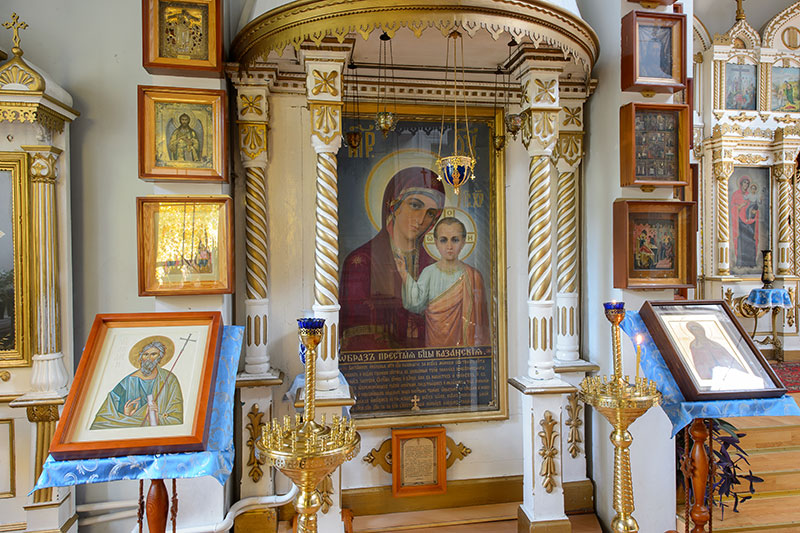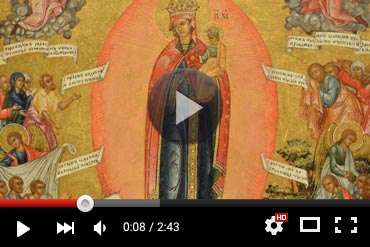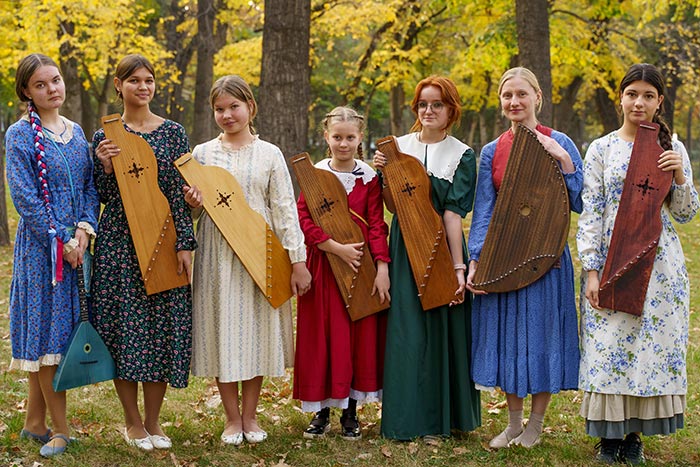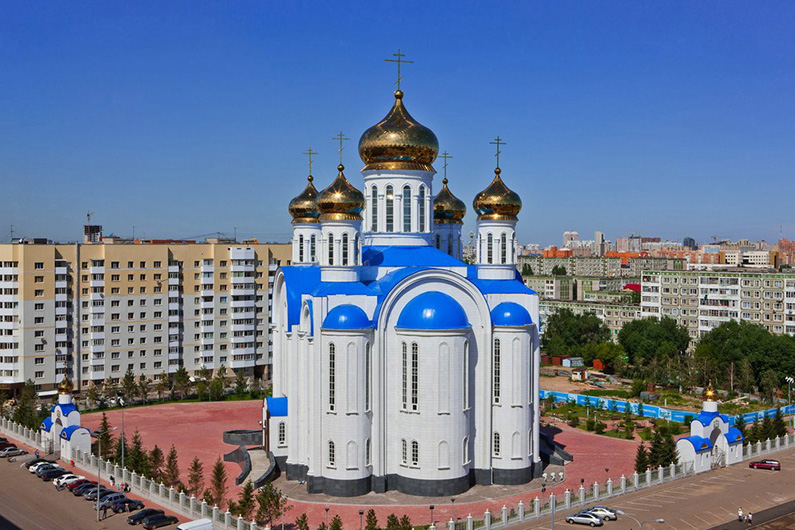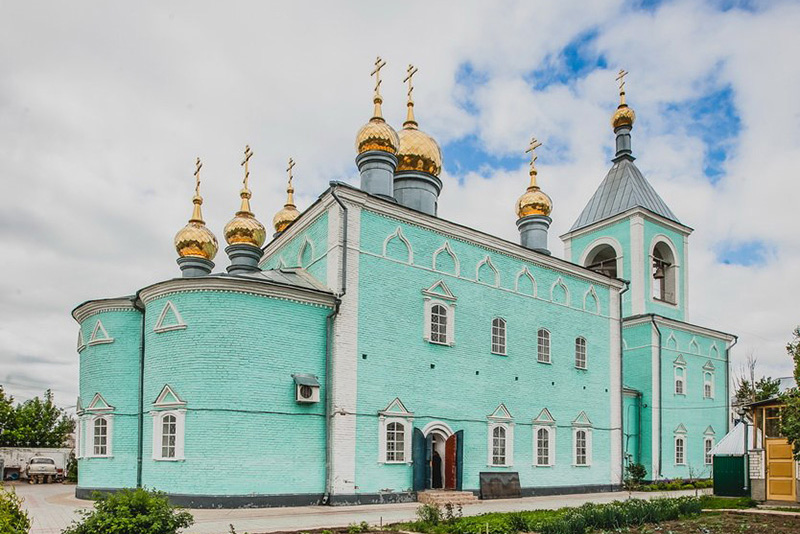
Metropolitan Alexander: “Through the prayers of the host of new martyrs and confessors of our Church, the Lord inclined His mercy to the people living on the Vyatka land.” Towards the revival of the Velikoretsk religious procession
- 06.06.2021, 00:56
- Новости на английском языке

June 6 – celebration in honor of the appearance of the Velikoretsk Icon of St. Nicholas the Wonderworker.
Every year from June 3 to 8, the All-Russian Velikoretsk religious procession takes place in the Vyatka Metropolis - a solemn procession with an ancient copy of the Velikoretsk image of St. Nicholas the Wonderworker to the bank of the Velikaya River, to the place of the appearance of the miraculous image. This is one of the largest religious processions in the Russian Orthodox Church, annually attracting tens of thousands of pilgrims.
We present to the attention of site visitors an article by Metropolitan Alexander of Astana and Kazakhstan, one of the main initiators of the resumption of the Velikoretsk religious procession in 1989.
The article was written for the twenty-fifth anniversary of the revival of the Velikoretsk religious procession.
The procession of the cross is an ancient and significant part of the life of the Church of Christ. It is impossible to imagine an Easter service, patronal day or celebration in honor of miraculous shrines without a majestic procession of clergy and believers with icons and banners, accompanied by the ringing of bells and the singing of prayers. Even in Old Testament times, we see prototypes of our sacred processions: in the exodus of God’s chosen people from Egypt to the Promised Land, in the transfer of the Ark of the Covenant to Jerusalem, in the circumambulation of the temple altar with palm and willow branches on the Feast of Tabernacles, in the ascension of pilgrims on the days established by the Law of Moses , to the Holy City.
Processions of the cross became firmly established in the liturgical life of the Church at the end of the 4th and beginning of the 5th centuries, and great credit for this belongs to St. John Chrysostom. At that time, the Arian heretics, who denied the Consubstantial Persons of the Most Holy Trinity, organized processions in the streets with the singing of chants to attract people. In contrast to them, Saint John Chrysostom began to organize processions, but more majestic and meaningful. The church historian Socrates Scholasticus testifies: “the confessors of the Consubstantial One performed their nightly hymns much more solemnly, for John came up with the idea of accompanying them by wearing silver crosses in the light of wax candles.”
Thanks to the works of the fathers and teachers of the Church, the procession of the cross becomes not only a special type of prayer, but also a solemn crowded testimony to the pagans and heretics of the main truths of Orthodoxy, a form of proclamation and defense of the true faith.
One can trace how, over time, religious processions began to be given ever deeper meaning. From St. Simeon, Archbishop of Thessalonica (XIV century), we read: “let us lift up sacred icons from churches, wear out honorable crosses and the most sacred relics of saints in order to sanctify people and everything they need for life - that is, houses, paths, waters , the air and the earth itself, as if trampled and desecrated by the feet of sinners. All this is so that the inhabited city and the whole country become partakers of Divine grace, rejecting from themselves everything destructive and pernicious.”
In the rules on religious processions, St. Philaret, Metropolitan of Moscow, explains their meaning as follows: “The earthly shrine signifies and calls upon the heavenly shrine; the presence of the cross of the Lord and holy icons and sprinkling with blessed water cleanses the air and earth from our sinful impurities, removes dark forces and brings light ones closer.” Through the singing of sacred hymns, burning incense, sprinkling with holy water, overshadowing with crosses and shrines, all the elements of nature are sanctified and blessed, the world returns to its pristine purity.
The definition of the Council of Bishops of the Russian Church (2008) states that religious processions are “a visible expression of the faith and piety of the people of God.”
The procession of the cross is also a deep prayer of repentance. The above-mentioned Saint Simeon writes that sacred processions outside churches and monasteries take place “in remembrance of our falling away, that we, who have fallen away, being, as it were, outside Eden, must humble ourselves and think that we are not worthy of holy places - heaven and heaven, and imitate the publican , who stood afar off in deep humility of his sinfulness, and Adam, expelled from paradise.”
For every believing heart, a procession of the cross is an experience of the direct presence of God, a time of close prayerful communication with the Most Pure Mother of God, angelic powers and holy saints, an image of the unity of the Heavenly Church, triumphant and the earthly Church, warring “against the world rulers of the darkness of this age, against the spirits of wickedness in high places.” (Eph. 6:12).
Along with the Orthodox faith, majestic liturgical rites came to Rus' from Byzantium, and, of course, religious processions, which became one of the most beloved liturgical traditions of our people. The history of the Russian Orthodox Church itself began with a religious procession to the Dnieper, where the baptism of Kiev residents took place. Chronicle sources, from the time of the Kyiv princes to the period of the reign of the Moscow tsars, provide information about numerous religious processions associated with the discovery of holy relics, the bringing of miraculous icons to Rus', significant events in civil history or national disasters. The tradition of performing all-church religious processions experienced its heyday at the beginning of the twentieth century. In 1903, a religious procession of many thousands took place with the participation of the Sovereign Emperor Nicholas II and members of the imperial family on the occasion of the discovery of the honorable relics of St. Seraphim, the Wonderworker of Sarov. In pre-revolutionary Russia, there were more than five hundred annual, regularly performed religious processions, some of which were long and even months-long, including walking around the surrounding villages and towns. The most famous of them are in the Tikhvin Mother of God Monastery with the miraculous Tikhvin Icon of the Mother of God, in the city of Kostroma and the Kostroma province with the miraculous Feodorovskaya Icon of the Blessed Virgin Mary, the monastery passage of the Nilova Stolbenskaya hermitage, in Kyiv - to the place of the baptism of Prince Vladimir of his sons, religious processions with Iverskaya an icon of the Mother of God from the Iversky Valdai Monastery through the cities and villages of the Tver and Nizhny Novgorod provinces, a religious procession from Mother See of Moscow to the Trinity-Sergius Lavra to the relics of St. Sergius of Radonezh, abbot of the Russian Land.
Among the famous religious processions, which were famous for their large crowds and enjoyed popular veneration and love throughout the Russian Church, the Velikoretsky religious procession stands out in a special way - one of the most ancient in our Fatherland.
Church tradition carefully preserves the memory of the appearance of the miraculous image of St. Nicholas, Archbishop of Myra, in the Vyatka region on the banks of the Velikaya River in 1383. Two decades later, the residents of Khlynov, the capital of the Vyatka region, asked to release the icon of St. Christ, famous for its numerous miracles, to the city, promising to bring the shrine to the place of its appearance every year. Thus, more than 600 years ago the tradition of the Velikoretsk religious procession was laid.
In 1555, the Velikoretsky Icon made its first trip to Moscow, where it was met by Tsar Ivan Vasilyevich the Terrible and Metropolitan Macarius of Moscow and All Rus'. The icon of St. Nicholas again visits the white-stone capital in 1614-1615 at the request of Tsar Mikhail Feodorovich Romanov. Thus, the shrine, revealed in the distant Vyatka region, gained great fame and began to be revered throughout Russia.
The first Vyatka archpastor, Bishop Alexander, who arrived at the newly established see in 1668, issued a decree on the celebration of the appearance of the Velikoretsk Icon on May 24 (Old Style). Since then, every year thousands of pilgrims gathered on the banks of the Velikaya River to offer prayers to the saint of God, St. Nicholas. They sailed there along the Vyatka and Velikaya rivers on rafts and special plows, since the religious procession was initially carried out by water.
Since the journey by water was not convenient and accessible for everyone, His Grace Lavrenty, Bishop of Vyatka, blessed it in 1778 to make it by land. Thanks to this, the number of participants has increased significantly. From the end of the 18th to the beginning of the 20th century, pilgrims walked from Vyatka through ancient villages: Fileyskoye, Makarye, Bobino, Zagarye, Monastyrskoye, Gorokhovo, Medyany. In each locality, prayer singing was performed with the participation of all residents of the village and surrounding villages. According to the recollections of old-timers, pilgrims were greeted with joy and respect, as ascetics performing significant prayer work.
After the October Revolution of 1917, a terrible era of persecution of Holy Orthodoxy by the Soviet authorities began. According to the thought of the Hieromartyr Irenaeus of Lyons, “the devil is the monkey of God.” Instead of Christianity, with its saving services, the atheists created and began to implant their own pseudo-religion in the country, with a parody of sacraments and rituals. In order to replace the idea of a religious procession in the minds of the Russian people, the Bolsheviks organized festive demonstrations in which red flags replaced banners, portraits of the leaders of communism - icons, and chanting slogans and shouts of “hurray!” - cathedral prayer.
In Vyatka, in the first years of Soviet power, despite persecution, thousands of pilgrims continued to make pilgrimages to the Great River. But in the 1930s, only brave confessors of the faith dared to make individual pilgrimages. In 1959, at the height of Khrushchev’s persecutions, an official ban on pilgrimages to the Velikaya River was published; police cordons were installed along the route, whose task was to look for pilgrims and take them by car as far as possible from the holy place.
The Lord says: “My thoughts are not your thoughts, nor are your ways my ways... But as the heavens are higher than the earth, so are my ways higher than your ways, and my thoughts higher than your thoughts” (Isa. 55:8,9). Through the prayers of a host of new martyrs and confessors of our Church, the Lord bowed His mercy to the people living on the Vyatka land.
Since the mid-80s of the twentieth century, the icy shackles of forced atheism began to gradually weaken, believers stopped being openly persecuted and persecuted, and their legitimate demands began to be gradually listened to. A huge interest in church life arose in society in the year of celebrating the 1000th anniversary of the Baptism of Rus'.
At this time, in the Kirov diocese, as the Vyatka Metropolis was then called, the ever-memorable Archbishop Chrysanthos (later the first metropolitan of the Vyatka region) performed his church work. The archpastor tried by all available means to soften the blows of government officials against Orthodoxy. This concerned commissioners, district managers and senior management of the Kirov region. The Bishop wanted every opportunity to be used for the good and benefit of the Church.
We, the young clergy of the Kirov diocese, inspired by the example of Archbishop Chrysanthos and strengthened by his blessings and prayers, have a desire and determination to return to our region the forcibly rejected tradition of pilgrimage to the Velikaya River, to the place of appearance of the shrine dear to the heart of every Orthodox Vyatichi.
In 1989, Bishop Chrysanthos turned to the authorities with a request to allow a religious procession and worship on the Velikaya River. As a result of difficult and very tense negotiations, the religious procession was allowed, but only in a truncated form.
The clergy and believers performed it from the village of Chudinovo to the village of Velikoretskoye - the place of the appearance of the miraculous image of St. Nicholas. Once upon a time, residents of nearby villages and pilgrims from Vyatka flocked to Velikoretskoye through this village, which is why the church leadership determined this route. In the church in the village of Chudinovo in pre-revolutionary times there was an ancient revered image - the Tikhvin Icon of the Blessed Virgin Mary, to which a large number of believers also flocked.
Before continuing to talk about the procession itself, I would like to mention one more important event. A few days before the start of the Velikoretsk holidays, Archbishop Chrysanthos, together with me, who was then serving as secretary of the Kirov diocesan administration, were invited to the Regional Executive Committee. The Chairman of the Kirov Regional Council of People's Deputies Vasily Alekseevich Desyatnikov met us with emphatic politeness, with a smile on his face, offered tea, and then, for two hours, he tried his best to dissuade us, asking and persuading us not to revive the tradition of the Velikoretsk religious procession under any circumstances. He said that it would be better to carry out all this after some time and that the Kirov diocese should not be the first in the country to go to a procession of the cross, since there had never been such church events in any city in the Soviet Union. Bishop Chrysanthos showed firmness, saying that he had made a final decision, which he does not intend to change, since several thousand people are asking for the revival of the Velikoretsk pilgrimage and the newly adopted law allows for open-air rallies and other public events, including religious processions . The authorities of the Kirov region capitulated to the persistence of Archbishop Chrysanthos and the decisive desire of the clergy and the congregation of believers. Several thousand people signed the appeal to allow the religious procession. The words of the Savior came true: “Ask, and it will be given to you; seek and you will find; knock, and it will be opened to you; For everyone who asks receives, and he who seeks finds, and to him who knocks it will be opened” (Matthew 7:7-8).
The archpastor gave me his blessing to lead all events related to the preparation and conduct of services for the revived Velikoretsk celebration.
A working group was immediately organized whose task was to improve the route from Chudinov to Velikoretsky. Along the old rural road leading through forests and fields, bridges were built across rivers and streams, fallen trees were cleared, holes were filled in, and a ferry across the Velikaya River was repaired for ease of crossing. These difficult works were led by the head of the household of the Serafimovsky Cathedral, Georgy Mikhailovich Katsemonov. Previously, we walked with him along the approved route of the revived religious procession from Chudinovo to the Velikaya River. This distance is almost 10 kilometers. The following labored with special zeal in preparing for the sacred event: Archpriest Vasily Galich, the keymaster of the Seraphim Cathedral; nun Lyubov (Klabukova); employee of the Seraphim Church Konstantin Kosnyrev - foreman of the working group; Kalisa Vasilyevna Ovchinnikova – chief accountant of the Kirov diocesan administration; Viktor Sergeevich Shchelchkov – headman of St. Seraphim Cathedral; spouses Prokopy Ivanovich and Nina Prokopyevna Klepikov; Lidia Ananyevna Tartysheva – treasurer of the Seraphim Church; Logvinov Andrey Nikolaevich – now an archpriest serving in the St. John the Theologian Church in the city of Kostroma; Vera Yakovlevna Lozhkina, currently the abbess of the Assumption Teterinsky women's hermitage in the Kostroma diocese. Photographer Oleg Arbuzov was appointed responsible for photographic recording.
Oleg Nikolaevich Ovchinnikov, currently the secretary of the Kazakhstan Metropolitan District, Honored Artist of Russia, prepared a choir from the Trinity Church in Makarya, which adorned the Liturgy on the Velikaya River with its soulful and prayerful singing.
Finally the long-awaited moment has arrived. An endless stream of buses carrying pilgrims moved from the Seraphim Cathedral in the city of Kirov to Chudinovo. More than five thousand people took part in the newly revived celebration.
The main shrine of the revived Velikoretsk religious procession was an exact list, “measure in measure,” from the revealed miraculous image of St. Nicholas, Archbishop of Myra, created in the 17th century. Since ancient times, this copy of the Velikoretsk Icon has been revered by believers as healing and miraculous. During the years of Soviet power, he stayed in the only church in the city of Kirov - St. Seraphim Cathedral. The very revealed icon of the Mirliki saint disappeared without a trace in the 20s of the last century from the Trinity Cathedral of Vyatka, where it was located for prayerful worship in the left aisle. The Trinity Cathedral, from which the Velikoretsk religious procession once began, was destroyed in 1935.
In ancient times, in the Velikoretsk religious procession, along with the revealed image of St. Nicholas, several revered shrines were carried - the Tikhvin image of the Most Holy Theotokos, the icon of the Archangel Michael and the icons of the Vyatka wonderworkers St. Tryphon and Blessed Procopius. We restored this tradition and in the revived procession we also carried the Tikhvin Icon of the Queen of Heaven, the image of the Archangel Michael and the icons of the Vyatka saints.
On the eve of the procession in the Trinity Church in the village of Chudinova, a host of clergy and a huge crowd of people celebrated the Divine Liturgy. Bishop Chrysanthos blessed me to lead the festive service. Among the concelebrating clergy were Archpriest Gennady Sukharev, Archpriest Alexy Sukhikh from the city of Vyatskie Polyany, Archpriest Vasily Galich, Priest Nikolai Toropov from the city of Khalturin (now the city of Orlov), priests Daniil Brynchak and Alexander Obukhov, who are currently serving in the Kostroma diocese ; Protodeacon Mikhail Spelnik – now Honored Artist of Russia, head of the cultural department of the Kazakhstan Metropolitan District; Protodeacon Georgy Bakharevsky and Peter Butyugov, Deacon Vladimir Markov, and many other clergy of the Kirov diocese.
After the completion of the Liturgy, having erected an icon case with a revered copy of the Velikoretsk Icon of St. Nicholas, raising altar crosses and banners, taking the icons in their hands, the pilgrims, with prayer on their lips, set off in the direction of the village of Velikoretskoye. But even here, opponents of the religious procession did not abandon their attempts to disrupt the sacred celebration. The Commissioner of the Council for Religious Affairs under the Council of Ministers of the USSR for the Kirov Region, Arkady Alekseevich Shalaginov, and his deputy, Valery Georgievich Shabalin, tried to persuade the clergy and believers not to go to the religious procession, but to limit themselves to prayer in the village of Chudinovo. Their words were not accepted, and since the official permission of the Kirov Regional Executive Committee was previously received for the religious procession, it took place.
As soon as the huge procession of the cross, stretching over a long distance, crossed fields and forest roads, approached the place of the appearance of the miraculous icon, a quick warm rain fell, refreshing the pilgrims after their labor. At that moment, a rainbow shone over the village of Velikoretsky, as a sign of God’s mercy. Each traveler's heart trembled, some special spiritual uplift and enthusiasm was felt. The singers from the Trinity Church in Makarya were enthusiastically supported with their voices by lovers of church singing - Protodeacon Georgy Bakharevsky and his son Alexander (now a priest in the Tsarevo-Konstantinovsky Church in the city of Vyatka), an expert in church charter - nun Daria (Balesina) (today - schema-nun in Iversko -Seraphim Monastery of Alma-Ata), nun Seraphim (Gordeeva); Fufacheva Antonina Georgievna (great-niece of the canonized Hieroschemamonk Stefan (Kurteev)), Alexandra Kozulina and Lydia Afanasyevna Golysheva.
The inner sensations were as if we were celebrating the Holy Resurrection of Christ. This mood was revealed in the singing of Easter irmos, torpars and stichera; over the forests and meadows the hymn of the victory of life over death was heard loudly, thousands of people “with one mouth and one heart” proclaimed “Christ is risen! “Truly he is risen!” Everyday sorrows and hardships were forgotten, physical infirmities and illnesses receded, our souls were filled with Heavenly consolation. The thousands of pilgrims became one big Christian family. This was repeatedly recalled in subsequent years by people who took part in the solemn procession.
I also remember such a case. A duty helicopter flew over the religious procession in the sky. The pilots noticed that they were being noticed, and they responded to the greetings of the marchers on the ground with a greeting in the air, shaking the body of the car.
The church procession was warmly received by the residents of the village of Velikoretskoye - they sheltered the travelers, treated them to dinner, gave them tea, and accommodated them for the night.
We spent almost the entire night, on the eve of the celebration of the appearance of the miraculous icon of St. Nicholas, in prayers and spiritual conversations; people confessed, read the rule for Holy Communion, and sang akathists.
Created in the 18th-19th centuries, the majestic temple complex of the village of Velikoretsky - “Velikoretsky Castle”, which includes the Transfiguration and St. Nicholas churches and the Ilyinskaya bell tower, was in a deplorable state, there were no crosses on the domes, instead of windows there were gaping holes in the rooms and on territory - piles of garbage. Believers were not allowed to put the churches in order, and therefore the main prayer service with an akathist was performed in front of the gates of the Velikoretsky Castle.
Early in the morning, in the predawn cool, along a dew-covered road, pilgrims walked from the village of Velikoretskoye to the place of the appearance of the miraculous face of the Myra saint. Here, in the open air, everything was prepared for the celebration of the Divine Liturgy, the clearing was put in order, the holy spring, which they had once tried to destroy, was cleared, a throne, an altar, candlesticks and all the necessary utensils were brought from the city of Vyatka. The revered image of St. Nicholas was installed on a special pedestal, on an elevated place and decorated with garlands of fresh flowers.
Before the start of the service, an extraordinary silence fell on the banks of the Velikaya River, and trembling seized the hearts of the believers. Amidst the general silence, a melodious, euphonious bell ringing was heard. A portable belfry was brought from the city of Kirov and installed at the place of worship. Bell ringer Alexander Maksimov created a special solemn atmosphere with his skill.
The Liturgy began. About 30 priests who came from various places in the Vyatka land served with me. The banks of the Velikaya River joyfully resounded with the touching singing of the choir from the Trinity Church in Makarya, under the direction of Oleg Ovchinnikov. People were on their knees, bowing their heads, many had tears in their eyes, everyone listened with great reverence to this first Divine Liturgy after many years of ban. The prayer filled our hearts with a special thrill, a very deep, spiritually powerful feeling. Along with the pilgrims, nature rejoiced, sanctified by the grace-filled light of the Eucharist. The feeling of Easter joy continued to pour out in jubilant cries of “Christ is risen!” Those present at this service said that it felt as if “angels descended from heaven and participated in the celebration together with the pilgrims.”
Among the worshipers were those who remembered the annual Velikoretsk religious procession of many thousands before the ban on its holding by the Soviet authorities; there were also many who, during the years of the atheistic regime, secretly went to the Great River, enduring sorrows and persecution, reproaches and mockery. Among them are Elizaveta Alekseevna Yurasova, Vera Aleksandrovna Kushova, Taisiya Dmitrievna Plenkina, Zinaida and Nikolai Rogozin, Nadezhda Alekseevna Novoselova, Alexandra Pavlovna Plenkina, Klavdiya Melnikova, Ekaterina Noskova, Vera Aleksandrovna Rogozina from the city of Slobodskoye, Boris Syutkin from the village of Volkova, Maria Nikolaev on from the city of Kirov, my mother - Anastasia Mikhailovna Navagina and many, many others. Some of them are alive, but the majority have already reposed in the Lord. Eternal and grateful memory to them and to all the ascetics of faith and piety who preserved in their hearts love and devotion to the Church of Christ and passed on their native Orthodox faith to subsequent generations.
The Lord has repeatedly vouchsafed me, during the years of administrative persecution, to walk with prayer to St. Nicholas along this ancient path of grace.
About three thousand people began the Sacrament of Holy Communion that day.
Even the leaders of the regional government, among whom was the secretary of the Regional Executive Committee, Galina Nikolaevna Smerdova, attended the service.
The ancient pious custom of our ancestors was revived. The following year the religious procession was repeated, gathering an even larger number of pilgrims. Since 1992, it has taken its historical route from the main cathedral of the city of Vyatka, and now every year on June 6, thousands of pilgrims from all over Russia and countries near and far abroad gather at the site of the appearance of the miraculous image of St. Nicholas. Velikoretsk celebrations have become one of the brightest events in the spiritual life of our Church. In 2000, the Velikoretsky religious procession received All-Russian status.
By the grace of God, through the prayers of the new martyrs of the twentieth century, the time came when the people were able to freely express their religious faith, revive the Velikoretsk religious procession and worthily glorify the wondrous saint and wonderworker Nicholas, “the source of miracles and the great intercessor of the faithful.”


